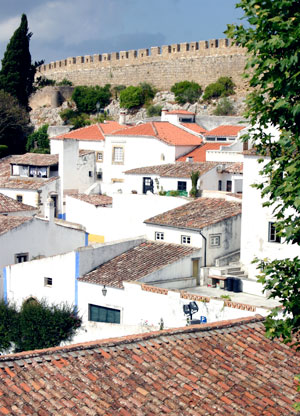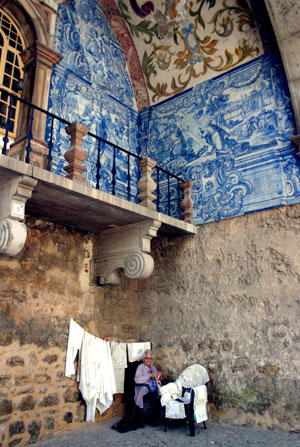ÓBIDOS, PORTUGAL - The blackened oak doors of the 14th century Bar Ibn Errik Rex are closed the day we arrive with a local man named Luis Garcia.
“Bruno (the owner’s son) must be playing on the computer again,” complains Luis as he checks his watch. “It’s 11 (a.m.) – the bar should be open. Wait here. I’ll be right back.”
With that, the portly Luis charges down the main street of this UNESCO World Heritage town in search of someone to open the bar where they serve a potent local wine made of sour cherries, honey, sugar and cinnamon called Ginja.
Luis’ absence gives us a chance to tour this beautiful walled city built by Moorish armies in the 8th century and which now draws over a million tourists a year.
Óbidos’ main street, Rua Direita, is an arms-wide road bordered by stone fences with lovely flowers cascading over them.

Above: Óbidos is a UNESCO town.
Rua Direita also leads us to most of the city’s ancient highlights, like the 15th century Memorial Cross; Saint John the Baptist Church, founded by Queen Isabel in 1309; the Town Gate, built in 1309; the 13th century St. Peter’s Church; Saint Martin’s Chapel, circa 1331; the five-mile long aqueduct ordered built by Queen Catherine of Austria in the 16th century; a 14th century synagogue, and the gates of the perfectly preserved Moorish castle.
From atop the thick walls of the castle we get a panoramic view of the town and its red-tiled roof homes and churches – the latter numbering 10 in an area not much bigger than two city blocks.
The refurbished castle now serves as a small luxury hotel – Portugal’s first historic pousada (inn). The white stucco hotel with the long exterior staircases offers only nine rooms and the most popular are two that sit atop the castle wall in a large turret.
Unlike their English counterparts, though, Portuguese castles don’t claim to have ghosts.
“However, if our guests want ghosts, then we have ghosts,” laughs a porter who guides us through the comfortable hotel featuring cozy public areas and a top-notch restaurant.
As we explore the town where only a few hundred people now live, we’re mesmerized by the hand-painted tiles that cover the churches – the handy work of the local women, we learn later.
Because Óbidos sits between Lisbon and Fatima (the religious icon is about 50 miles away) its cobbled streets are usually full of tourists and in high season space can become a challenge.

Above: Óbidos is a town of old people and old streets.
Tourists will eventually pass the old doors of the Bar Ibn Errik Rex (Son of Erik the King) where Luis and Bruno are now standing, waiting our return.
“I was right. Bruno was playing with his damn computer,” says Luis.
Bruno, the third generation of his family to run the bar, just smiles and ushers us inside the cramped, dark property where over 1,800 tiny wine bottles hang from its rafters.
“It’s time to sample Óbidos’ most important product – our Ginja,” says Luis as Bruno pours the ruby colored liquid into our glasses. He also produces a bottle of sour cherries and asks us to taste the bitter-tasting base product for the wine.
“Amazing how something so sour can turn into something so sweet,” says Luis as he downs his wine.
While we enjoy our Ginja, Bruno tells us that he and his father, Antonio, now own the bar, which first started out as his grandfather’s antique store, which opened in 1955.
“My grandfather would treat his customers to a glass of Ginja when they came into shop but soon all the people wanted was the Ginja, not the antiques. So he converted the store into a bar.”
Grandpa’s antiques, by the way, now serve as the bar’s furnishings.
After a few glasses of Ginja, it was time to resume our tour with Luis, who drew our attention to a massive rock sitting at the base of the castle’s outer castle wall. The nimble Luis climbs the boulder and points to a cross carved into the stone.
“The cross was put there by the Knights Templar,” says Luis – the same Knights Templar recently resurrected in the Dan Brown book, the De Vinci Code.

Above: Óbidos is one of Portugal's most coloruful towns.
The Moorish castle was only conquered once – by Portuguese forces in the 12th century. But it took them three months to finally scale the walls. The Moors were allowed to stay in the village after the battle and many of their descendants still live in the lovely white brick homes that line the small streets outside the castle, which once served as Portugal’s Royal Palace. fter several enjoyable hours touring Óbidos and buying some of its treasures, it was time to pass under the town’s main gate and head back to the parking lot.
An old lady sitting under a canopy of hand painted tiles looked up and muttered something in Portuguese.
“She wishes you a good journey and thanks you for visiting her town,” translates Luis. It was a visit that will be long remembered.
Information
- The Bar Ibn Errik Rex is located at 100 Rua Direita. You can contact Bruno by email at baribnerrikrex@oniduo.pt
- For information on the castle hotel, go to www.senhorasrainhas.com.
- For more on Óbidos go to www.cm-obidos.pt.
About the Author
Marc Atchison is a veteran journalist and a seasoned traveller with more than 20 years of travel writing experience. As the former Travel Editor of the Toronto Star, Canada's largest newspaper, and now Editor-in-Chief and Senior Writer for TraveLife magazine (Canada) and travelife.ca, Marc has been to over 100 countries in the world. Japan is one of his favorite destinations and he's been there on numerous occasions.